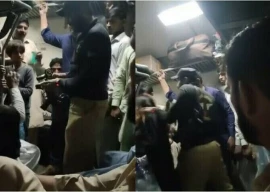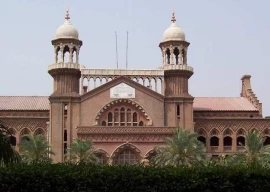PESHAWAR:
It could be said Qasim Ali Khan mosque in Peshawar has a unique relationship with the moon. Every 12 months (in the month of Ramazan), the moon seems to make an appearance which is seen by few. The maulana of said mosque is among these.
It could also be said that Qasim Ali Khan mosque imprints not only the socio-cultural life of Peshawar, but also Pakistan’s, as it splits Eidul Fitr celebrations across the country.
The annual controversy has two phases, once at the start of Ramazan and once at the end, pushing the mosque to the center stage of national discourse. The residents of Khyber-Pakhtunkhwa invariably start and end fasting according to the announcement made by the mosque’s khateeb – currently Mufti Shahabuddin Popalzai.
Situated in Bazaar Misgaran near Qissa Khwani, Qasim Ali Khan along with three other mosques of the city has its own creation myth. According to local lore, Nawab Mohabbat Khan, the Mughal governor of Peshawar, and his three brothers constructed mosques in the city named after them: Mohabbat Khan, Gunj Ali Khan, Qasim Ali Khan and Dilawar Ali Khan.
This legend is so popular with the citizens of Peshawar that it obfuscates the real identity of the builders of Qasim Ali Khan mosque.
Other contenders include one of Emperor Akbar’s engineers, Qasim Khan. He was the first to lay road through the Khyber Pass and was later appointed the governor of Kabul and Peshawar.
Qari Javed Iqbal in his book Saqafat-e-Sarhad; Tareekh Kay Ainee Main notes the Auqaf department dates the mosque to 1842. He writes that Qasim Ali Khan mosque was built when Peshawar was under Sikh rule.
“The construction of the outer portion dates back to 1941 […] this newer construction did not affect the mosque area.”
Even though Iqbal dates the mosque, he stayed out of the fray which surrounds the identity of the person to whom the construction of the structure can be attributed to.
An associate professor at the University of Peshawar’s archaeology department is bolder in his assumptions. Dr Ibrahim Shah, who has worked on the attribution tradition surrounding one of Peshawar’s oldest mosques, tells The Express Tribune that the mosque’s potential namesake Qasim Ali Khan was a junior officer under Emperor Auranzeb’s rule. Qasim Ali Khan was a junior rank official of the Mughal administration but was not the governor.
“Dilawar Khan and Gunj Ali mosques also date back to Aurangzeb’s period and these were also named after government officials,” adds Dr Shah.
The round of construction undertaken at Qasim Ali Khan mosque in the 40s was financed by Haji Ghulam Samdani, one of the richest people in Peshawar at the time.
An area adjacent to the main building houses the graves of Qasim Ali Khan and others.
The Popalzais of Peshawar
The Popalzais of Peshawar are a powerful people. They control when people stop and start a month designated for a religious practice dating back 1,400 years.
In Abdul Rahim Popalzai I’s biography (written by Abdul Jalil Popalzai), it was noted that Abdul Rahim was a Qazi of Peshawar during the Durrani rule in the 16th century.
Abdul Rahim preferred to remain in Peshawar after the Sikhs took over the city, and thereon began the documented legacy of the Popalzais in Peshawar.
Rahim’s son Hafiz Mohammad Amin was also a prominent religious figure of the city. Abdul Qayum in his book Mashaheer-e-Sarhad notes Amin’s son Mufti Abdul Hakeem Popalzai actively took part in the Khilafat Movement and was later appointed president of the Khilafat Committee. Abdul Hakeem was also appointed khateeb of Qasim Ali Khan mosque.
Mufti Hakeem had four sons; two of them died young. Hakeem was also made khateeb of Peshawar’s Eidgah. He was removed from this post, but a similar attempt to remove him from Qasim Ali Khan failed due to public opposition.
Left of centre
One of Hakeem’s surviving sons, Mufti Abdur Rahim Popalzai II (named after his grandfather), is one of the most prominent religious scholars of the province, also among the many Popalzais.
Born in the 1890s, he took part in the Khilafat Movement in his teens. Mufti Abdur Rahim Popalzai II would regularly publish a journal by the name of Sarfaroosh and remained engaged in the freedom movement against the British throughout his life.
With his leftist leanings, he and other “comrades” set up a youth organisation called Nawajan Bharat Sabha. When the British banned Nawajan Baharat Sabha, he was elected head of the Socialist Party.
Mufti Abdur Rahim Popalzai II also played a leading role in the events which lead up to the Qissa Khwani massacre and was sentenced to nine years in prison for his role in the uprising.
Abdul Jalil, one of his grandsons, explained his leftist leanings in the biography. “Abdur Rahim Popalzai [II] borrowed his anti-imperialist ideology from Maulana Obaidullah Sindhi and Maulana Hussain Ahmed Madani; they wanted to reverse the gains of the landed aristocracy […] acquired by conspiring with the British against freedom lovers.”
In 1939, Abdur Rahim Popalzai II protested in Bannu against the British bombing Waziristan, for which he was sentenced to five years imprisonment. He died in 1944.
Following his death, his younger brother Maulana Abdul Qayyum Popalzai became the khateeb of Qasim Ali Khan.
The current khateeb is Mufti Shahabuddin Popalzai, Abdul Qayyum’s son.
Published in The Express Tribune, July 26th, 2014.
COMMENTS (2)
Comments are moderated and generally will be posted if they are on-topic and not abusive.
For more information, please see our Comments FAQ











































One of our friends wrote this status on his Facebook wall that start of the Ramzan and End of Ramzan are....
"The only time of the year when Mufti Popalzai gets more popularity than Justin Bieber"
And he is dead right, on Eid Night his name was talk of the town.
very informed article, but there was no Durrani rule in the 16th century !